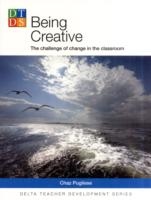Manifesto for Creative Teaching
Chaz Pugliese, France
Chaz Pugliese is a teacher and teacher trainer associated with Pilgrims, UK. Chaz works out of Paris, France. Apart from Creativity, his interests vary from spoken grammar to motivational issues. Chaz is author of “Being Creative” resource book with DELTA Publishing (2010). E-mail: chazpugliese@gmail.com

Creativity, the skills of manufacturing ideas or product that are new and culturally valued, is an essential component of teaching in a 21st century school. While marginalized, trivialized and misunderstood by many, creativity is fundamental to teaching, as it requires both deep knowledge and playful use of that knowledge to create new connections, exercises, solution paths, and forms of expression. Most of all, creativity is needed to provide the students with three elements without which teaching is reduced to hopeless boredom: novelty, surprise and variety.
- Teaching is about spontaneous expression.
- Teaching is a conversation between human beings regulated by the sound of the human voice.
- A key responsibility of the teacher is to enable these conversations to take place in the classroom.
- Too much preparation/too many materials kill conversations.
- Conversations are, by definition, unpredictable.
- So are lessons.
- As a result, teachers must learn to improvise in order to deal with unexpected events.
- Most educational systems alienate teachers from their work by stripping it of any creative endeavor and reduce it to following scripted lesson plans.
- Creativity is a tool that helps teachers find their individual voice, and teach from the heart.
- Creativity is a tool needed to stimulate the students’ curiosity and create pedagogic surprises.
- Creative teachers do not deliver information but strive to facilitate the students’ encounter with the language and to maximize learning opportunities.
- Because lessons are heavily context-dependent, there can’t be a best method for teaching languages.
- Nor is there an algorithm.
- Creativity frees teachers from all methodological dogmas so they can teach unencumbered by unhealthy theoretical constraints.
- But learning to teach creatively is not a parlor trick or something that can be lifted off the web.
- It follows that teachers must be adequately trained.
- But first they must convince themselves that creativity can be learned.
- And conquer their fears.
- Refusing to try out new ideas because ‘I teach exam classes/have a strict syllabus’ is giving in to fear.
- Refusing to try out a new teaching idea ‘because I know my students won’t take to it’, is giving in to fear.
- Refusing to try out an idea ‘because I’ve never done this before” is giving in to fear.
- Experimenting, breaking rules are examples of creativity at play.
- Walking into the classroom with a plan but also with a ‘let’s see what happens’ attitude is an example of how a creative teacher thinks.

Please check the Creative Methodology for the Classroom course at Pilgrims website.


|